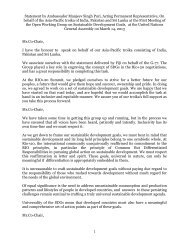STATE OF THE WORLD'S CITIES 2012/2013 Prosperity
STATE OF THE WORLD'S CITIES 2012/2013 Prosperity
STATE OF THE WORLD'S CITIES 2012/2013 Prosperity
You also want an ePaper? Increase the reach of your titles
YUMPU automatically turns print PDFs into web optimized ePapers that Google loves.
State of the World’s Cities <strong>2012</strong>/<strong>2013</strong><br />
Box 3.2.1<br />
Measuring Innovation and Creativity<br />
In 2000 a “Creative City Index” was developed to measure<br />
‘the imaginative pulse of cities’, combining a variety of<br />
indicators ranging from political and public frameworks,<br />
diversity, vitality and expression, openness and tolerance,<br />
entrepreneurship, vision, liveability, learning and<br />
professionalism, among 10 specific dimensions. In 2007,<br />
Melbourne-based “2thinkNow” developed an “Innovation<br />
Cities Program” along with an “Innovation Cities Index” in a<br />
bid to enhance understanding of the links between innovation<br />
and the way cities operate. The measure also uses a large<br />
variety of indicators, involving cultural assets, infrastructure<br />
and networked markets in areas such as commerce, finance,<br />
food, the arts, health, technology, religion, the media, etc.<br />
On this basis, cities are classified in five categories: ‘nexus’<br />
(cities featuring critical innovations),’hub’ (cities that are<br />
influential in key areas), ‘node’ (cities combining broadranging<br />
performance and imbalances), ‘influencer’ (cities that<br />
are competitive but unbalanced on the whole), and ‘upstart’<br />
(cities with potential for future performance).<br />
Source: UN-Habitat (<strong>2012</strong>) Decentralization in Iraq: Challenges and<br />
Solutions for Federal and Local Governments, Nairobi: UN-Habitat<br />
POLICy<br />
A creative city must establish a balance between<br />
‘hardware’ factors – infrastructure and technology –<br />
and ‘software’ factors (including mind-set, dynamics of place, the<br />
connection between thinkers and doers, and a change-friendly<br />
environment). 7<br />
<strong>THE</strong> FACTORS BEHIND URBAN INNOvATIvENESS<br />
Innovation can emanate from a creative worker, a<br />
community leader, a business person, an artist, a public<br />
servant or a scientist, etc. Innovation can respond to a<br />
specific problem, reduce risks, anticipate challenges, result<br />
in new products or process, or harness existing or emerging<br />
opportunities. For the purposes of urban prosperity,<br />
innovation has a clear role in improved conditions for<br />
populations and the way they live, work, move, relax and<br />
more generally make the most of the urban advantage.<br />
If its existing<br />
creative capital is to be<br />
POLICy<br />
The culture of<br />
creativity must<br />
be embedded in the way<br />
cities operate. 8<br />
enhanced, or activated<br />
where dormant, a city<br />
should become a locus<br />
where sociocultural<br />
diversity can be staged,<br />
104<br />
and where links can flourish among both individuals and<br />
institutions. In practice, all of this requires well-adapted<br />
physical environments, which in turn have to do with<br />
urbanization economies9 and better urban planning. From<br />
a more institutional point of view, support to knowledge<br />
exchange and networking is another way of stimulating<br />
creative capital, along with favourable conditions for<br />
research and development. As for the productive sector,<br />
creative stimulation can also derive from economies of<br />
agglomeration and an entrepreneur-friendly environment.<br />
It may come as no surprise that in Asia, most<br />
local experts saw a strong link between research and<br />
development (R&D), on the one hand, and enhanced<br />
prosperity on the other, with public authorities and other<br />
stakeholders playing significant roles in the areas of<br />
business, industry and technology.<br />
This was the case in Singapore, Hyderabad and<br />
Bangalore (India), Shenzhen and Chongqing (China),<br />
Gaziantep (Turkey) and Cebu (the Philippines). In<br />
Singapore, gross expenditure on R&D increased from<br />
1.9 per cent in 1990 to 2.8 per cent 2008 and three<br />
per cent in 201010 , with the focus on applied research,<br />
technology, sustainable urban living and ‘clean’ energy. 11<br />
In Bangalore, the emergence of the city as a knowledge<br />
hub is a visible impact of policy, entrepreneurship and<br />
innovation. With more than 66 engineering colleges and<br />
55 polytechnics, the city has developed as a centre for<br />
scientific innovation, research in aeronautics and electronics<br />
with strong public research facilities. 12 Biotechnologies<br />
and computer/communications also feature highly in<br />
Hyderabad, India’s pharmaceutical capital, with support<br />
from central government and more than 40 research<br />
and educational institutions. 13 Shenzhen has developed<br />
an endogenous innovation strategy led by the state with<br />
investments from government agencies, industries and<br />
universities. In few years,<br />
the city has developed a<br />
high-tech, modern service<br />
industry, actively promoting FACT industrial transformation<br />
and upgrade, focusing<br />
on electronics, biological<br />
engineering and new<br />
material technology.<br />
The city has also made<br />
important innovations<br />
in the service industry<br />
(finance, logistics and<br />
UN-Habitat<br />
survey shows<br />
that five main factors<br />
are at play when cities<br />
innovate: innovative<br />
urban management,<br />
entrepreneurial capacity,<br />
the promotion of<br />
arts and culture, the<br />
emergence of industrial<br />
clusters, and research<br />
and development (R&D).




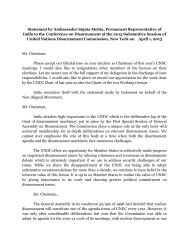
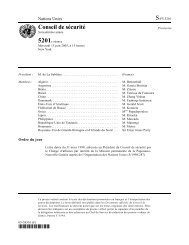

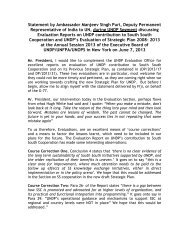

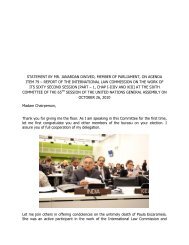



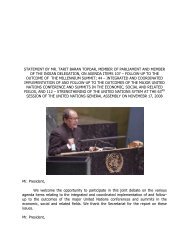

![1 statement by dr.[mrs] kakoli ghosh dastidar - Member States Portal](https://img.yumpu.com/27526598/1/190x245/1-statement-by-drmrs-kakoli-ghosh-dastidar-member-states-portal.jpg?quality=85)
